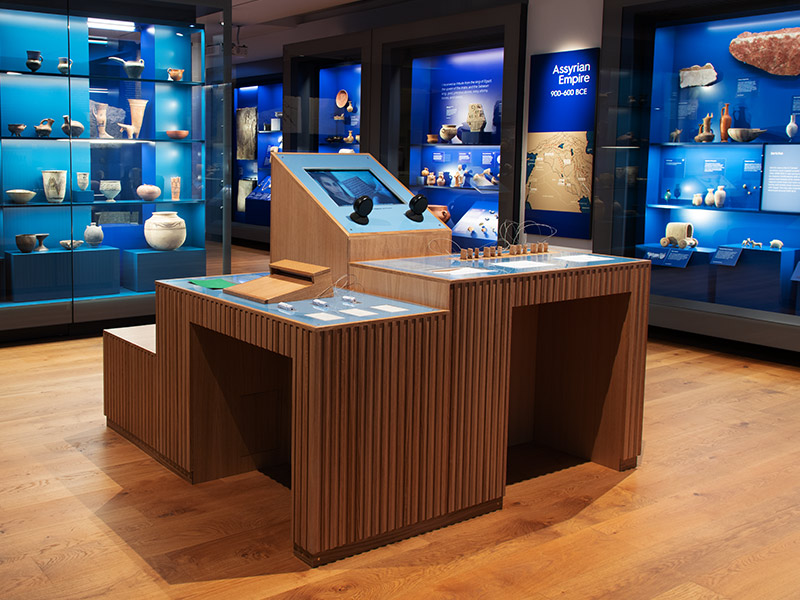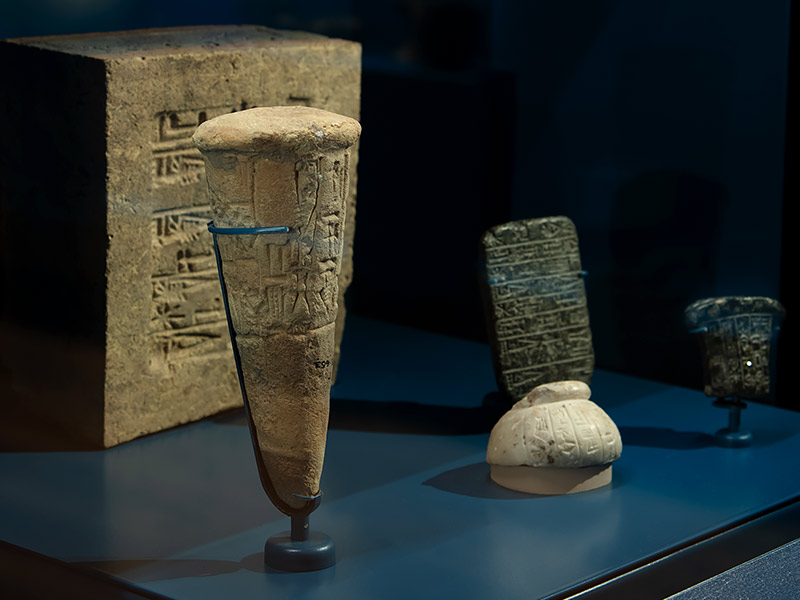Bringing the ancient Middle East to life
Through imaginative storytelling and innovative design, the Ashmolean Museum’s new Ancient Middle East Gallery creatively connects the ancient past to the present day.
‘The ancient Middle East is incredibly complex in its own right,’ says Dr Paul Collins, who held the Jaleh Hearn Curatorship of Ancient Middle East at the Ashmolean Museum until October 2022. ‘There were multiple languages and multiple peoples, different traditions and religions. Trying to reveal that to the uninitiated... it’s difficult enough for the initiated. The uninitiated just couldn’t find a way in.’
Dr Collins is reflecting on the museum’s former Ancient Near East Gallery, which had been installed as part of the major redevelopment of the museum in 2009. Although the location was excellent (ground floor, just inside the entrance), the space was not without challenges: low ceilings, poor lighting, little for visitors to interact with, and bookended by two enormous lightwells. ‘It became a passage from one brightly lit area to another,’ he says.
Individually, these issues might have been manageable, but when combined, they helped to create a space that, as Dr Collins puts it, ‘just couldn’t do what it needed to.’ Research revealed that people were commonly spending as little as 30 seconds looking at the displays – a particularly unfortunate finding given that the museum is one of the few places in the world where it is possible to trace, through objects, the stories of many of the ancient societies and cultures of the Middle East.
 Inside the Ashmolean’s new Ancient Middle East Gallery © Ashmolean Museum, University of Oxford
Inside the Ashmolean’s new Ancient Middle East Gallery © Ashmolean Museum, University of Oxford
The Ancient Near East Gallery might have remained like this for many more years had it not been for the Sarikhani family, whose generosity enabled a major redesign of the displays last year. With their support the gallery has been transformed into one that finally does justice to the incredible artefacts it showcases, and enables visitors to understand the lives – and deaths – of those who owned them.
‘I wanted every case to start with the idea that these objects were created by humans living in a real world, not isolated for artistic appreciation, but actually fundamental to their lives,’ explains Dr Collins. ‘It’s no longer about saying: you’re looking at a pot from this date. It’s now about saying: these objects were part of these people’s lives, this is what they did with them, this is how they thought about them... little windows, we hope, into those worlds.’
For Dr Collins, the Sarikhani family’s gift was an opportunity to totally rethink the rules of permanent exhibition design. ‘All of the exciting things that happen in museums around display, interpretation, design and engagement are very often with temporary displays,’ he says. ‘I wanted to learn from those experiences and find a way in which permanent galleries could be as exciting, dynamic and reflective as the temporary ones.’
The new displays focus on the peoples of ancient Iran, Iraq and the Levant, drawing on the latest scholarship, as well as innovative approaches to museum design and audience engagement, to tell their stories. Some of the changes that have been made to the space are instantly noticeable: gone are the traditional ‘tombstone’ labels listing object type, date and accession number, and in their place now sit narratives guiding visitors through some of the most fundamental developments in human history, from the origins of writing to the growth of organised states. New interactives have also been installed, giving visitors the opportunity to roll a cylinder seal or have a go at writing in cuneiform.
‘It’s extraordinary to have material to be able to tell these fundamental stories of humanity’
There are other, more subtle, changes too: magnetic labels and mounts have been used throughout, ensuring the displays can be easily updated to respond to changes in contemporary thinking or current events. And some are still being planned: while the labels in the gallery appear in English, in time they will also be made available in languages of the Middle East through visitors’ smartphones.
To guide this transformation, Dr Collins drew on the expertise of colleagues around the world, as well as of those at the Ashmolean and across the wider University. He also spoke with local people. ‘When it became more than just conversations and thinking, then we could engage with our audiences and actually ask them what they wanted,’ he says. One small but significant change to result from this approach was a new name: the Ancient Middle East Gallery – ‘much more meaningful to a contemporary audience,’ he adds.
This direct audience engagement continues today, with visitors invited to respond to the displays and stories told through them. Some of the feedback received has already led to changes, particularly in the ‘collecting and colonialism’ case, which explains how objects came to be in the museum. ‘We hadn’t got some of the language quite right,’ says Dr Collins. ‘It hadn’t been sufficiently critical in areas and so we’ve changed it, and that conversation we hope will continue.’
 Some of the objects on display in the gallery © Ashmolean Museum, University of Oxford
Some of the objects on display in the gallery © Ashmolean Museum, University of Oxford
Equally crucial in the redesign has been the opportunity to provide visitors with a place to consider the relevance of the ancient Middle East for the modern world. There is now a dedicated space in the gallery for co-curated displays, which will enable the museum to highlight not only the latest research from Oxford, but also reflections on the importance of heritage within the modern societies of the Middle East. The museum’s ongoing engagement work with local people, including those in the Kurdish community, will feed directly into this.
For Dr Collins, the transformation of the gallery was a leap into the unknown. ‘All these things, the magnetic labels, the storytelling with objects... would they work? We had no idea. But it was wonderful to be in a place that was willing to the take the risk,’ he says. The risk has clearly paid off. Recent analysis shows that people are now spending, on average, between seven and ten minutes looking at the displays. ‘It’s early days,’ notes Dr Collins, ‘but what I see today is what I hoped it would be, which is a fantastic place to be.’
Help the Ashmolean Museum to do more